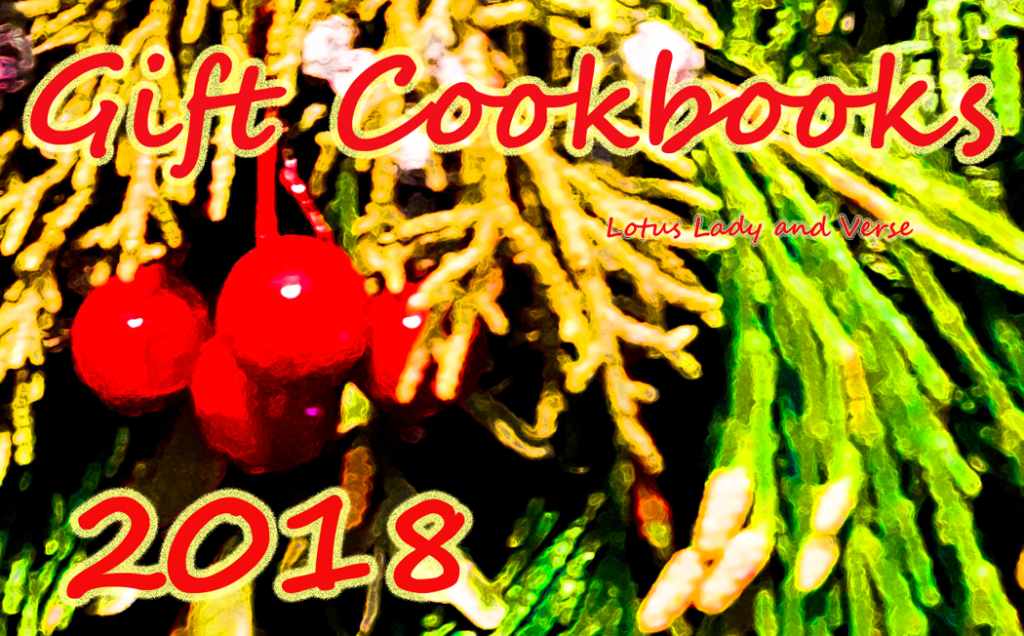 2018’s most creative cookbooks demonstrate the many flavors and ingredients that may be new to our kitchens. In fact, imaginative and inventive chefs are looking for flavor and texture from plants we may not know are edible. However, their flavors and textures are recognizable and when prepared well become delicious fare. Vegan, vegetarian or omnivore diners who love vegetables, fruits, herbs and spices, will want to cook and experience these “new” ingredients from their local terroir.
2018’s most creative cookbooks demonstrate the many flavors and ingredients that may be new to our kitchens. In fact, imaginative and inventive chefs are looking for flavor and texture from plants we may not know are edible. However, their flavors and textures are recognizable and when prepared well become delicious fare. Vegan, vegetarian or omnivore diners who love vegetables, fruits, herbs and spices, will want to cook and experience these “new” ingredients from their local terroir.
Tonic: Delicious and Natural Remedies to boost Your Health. / Tanita de Ruijt, 2017. Hardie Grant Books. 159 pages, illustrations in color.
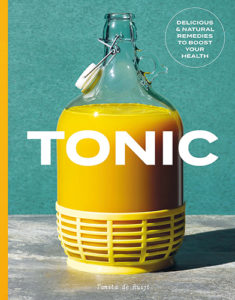
A lively and honestly-wrought book of recipes for healthful drinks, almost all of which are made with herbs and spices, Tonic should be your next book for drinks. Reaching out from the contents are the questions—Stressed? Tired? Hungover? Bloated? Sick? These are the conditions for which you can make yourself a reviving drink. Warm and warming tonics for each of the five conditions are presented, and you get cool and cooling drinks as well. Author Tanita opened Jamu Kitchen a shop in a London suburb and began creating and selling drinks based on the Indonesian concept of health called “jamu”.
Tahini and Turmeric 101 Middle Eastern Classics – Made Irresistibly Vegan. / Vicky Cohen and Ruth Fox, 2018. Da Capo Lifelong Books. 285 pages, illustrations in color.
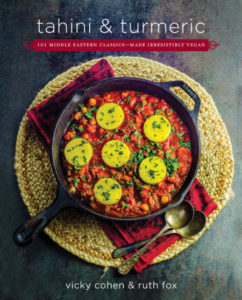
Mediterranean food, the Mediterranean diet and foods taste fabulous! Out of the need for interesting vegan fare, Tahini and Turmeric 101 Middle Eastern Classics—Made Irresistibly Vegan has manifested—in time for the season, your holidays and daily fare, whether you’re vegan or not.
And except for the breads which are the yeasted kind, the dishes are rendered quite simply using shortcuts wherever possible, and require just a little attention rather than a super chef’s hand. Sumptuous flavorings besides tahini and turmeric, such as rose and orange waters, syrups, and pomegranate only partially describe this versatile and tantalizing cuisine.
The Flavor Matrix: The Art and Science of Pairing Common Ingredients to Create Extraordinary Dishes. / James Briscione, Brooke Parkhurst, 2018. Houghton Mifflin Harcourt. 320 pages, illustrations in color. 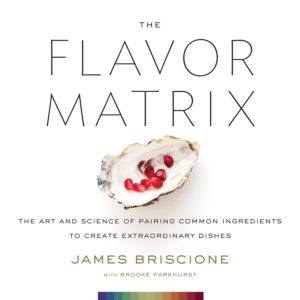
Flavor Matrix, a visually stunning book suggests flavor pairings you can try. Crafted for ambitious home cooks, chefs-in-training and food writers, a wealth of food data fits into a graphic image which I think of as a flavor wheel. The wheel displays at a glance the top choices for numerous variations or possibilities on a single ingredient.
If you’re visually-oriented, you’ll love this book—loads of information is conveyed at a glance. Plus the authors’ 50 recipes allow you to delightfully experiment, before you delve into the detailed information from computer synthesis of the seven tastes. Yes, seven—Umami, Sweet, Sour, Salty, Spicy, Fat, Bitter.
Forage, Harvest, Feast : A Wild-Inspired Cuisine. / Marie Viljoen, 2018. Chelsea Green Publishing. 409 pages, illustrations in color.
 36 wild, nearly-wild or little-cultivated herbs, roots, fruits and flowers are featured in Viljoen’s thoroughly researched and experienced recipes for preparing wild foods, making wild drinks and cultivating your wild sweet tooth. Prepare yourself to make a wide range of edibles from just one of these plants. You’ll have a cordial or fermented liqueur, a sweet chutney or jam, a vegetable sauce, and a spice rub for grilling from one or two foraged plants!
36 wild, nearly-wild or little-cultivated herbs, roots, fruits and flowers are featured in Viljoen’s thoroughly researched and experienced recipes for preparing wild foods, making wild drinks and cultivating your wild sweet tooth. Prepare yourself to make a wide range of edibles from just one of these plants. You’ll have a cordial or fermented liqueur, a sweet chutney or jam, a vegetable sauce, and a spice rub for grilling from one or two foraged plants!
How delicious! Perhaps wild-taste is the new 9th flavor sense?
Saladish : A Crunchier, Grainier, Herbier, Heartier, Tastier Way with Vegetables. / Ilene Rosen with Donna Gelb, 2018. Artisan, New York. 207 pages, illustrations in color.
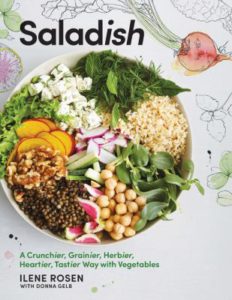 Saladish offers more than 80 recipes for salads, organized by the season of the year. An example of what’s current in winter are recipes for Sourdough Bread Salad, Sunchoke and Endive Slaw, and my favorite, Acorn Squash with Green Olives and Curry Dressing. There’s a recipe called Red and it’s got red beets and green ends, red quinoa, and pistachios dressed with Coriander Dressing—sounds delish alright! Because of its seasonal orientation, the book is valuable year-round especially for lunches and dinners and party-ish ideas!
Saladish offers more than 80 recipes for salads, organized by the season of the year. An example of what’s current in winter are recipes for Sourdough Bread Salad, Sunchoke and Endive Slaw, and my favorite, Acorn Squash with Green Olives and Curry Dressing. There’s a recipe called Red and it’s got red beets and green ends, red quinoa, and pistachios dressed with Coriander Dressing—sounds delish alright! Because of its seasonal orientation, the book is valuable year-round especially for lunches and dinners and party-ish ideas!
The Ultimate Vegan Breakfast Book: 80 Mouthwatering Plant-based Recipes You’ll Want to Wake Up For. / Nadine Horn and Jorg Mayer, 2018. Experiment, New York. 208 pages, illustrations in color.
 The Ultimate Vegan Breakfast Book is a beautifully-illustrated cookbook and one that I have learned a few tips from for cooking vegan omelets, pancakes and breads. Yet that is the least of the authors’ recipes—they offer many more—and ways you can add excitement into the first meal of your day. Besides sharing recognizably-delicious recipes for overnight oats and puddings, The Ultimate Vegan Breakfast Book is your next best source for a range of breakfasts, from smoothies to “The Full English”!—a menu of items on a plate that includes tomatoes, home fries and vegan sausage. The authors’ blog eat-this.org is purportedly popular in their home country of Germany.
The Ultimate Vegan Breakfast Book is a beautifully-illustrated cookbook and one that I have learned a few tips from for cooking vegan omelets, pancakes and breads. Yet that is the least of the authors’ recipes—they offer many more—and ways you can add excitement into the first meal of your day. Besides sharing recognizably-delicious recipes for overnight oats and puddings, The Ultimate Vegan Breakfast Book is your next best source for a range of breakfasts, from smoothies to “The Full English”!—a menu of items on a plate that includes tomatoes, home fries and vegan sausage. The authors’ blog eat-this.org is purportedly popular in their home country of Germany.
Healing Mushrooms: A Practical and Culinary Guide to Using Mushrooms for Whole Body Health / Tero Isaukappila, 2017. Avery an imprint of Penguin Random House. 212 pages, illustrations in color and black and white.
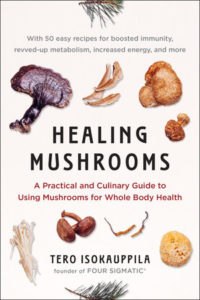 In this book, you get the science behind those odd-shaped, smooth or wrinkle-skinned, tail-less or not, fungi (mushrooms are a kind of fungi) we often see in variety on the produce shelves of supermarkets, even at the farmer’s markets when in season. Mushrooms such as Chaga(grows on birch and other trees), Reishi, Turkey Tail, Lion’s Mane, Snow Fungus and Sun Agaric—-are more likely to have health benefits, and may be found by foraging if you’re in the right place at the right time.
In this book, you get the science behind those odd-shaped, smooth or wrinkle-skinned, tail-less or not, fungi (mushrooms are a kind of fungi) we often see in variety on the produce shelves of supermarkets, even at the farmer’s markets when in season. Mushrooms such as Chaga(grows on birch and other trees), Reishi, Turkey Tail, Lion’s Mane, Snow Fungus and Sun Agaric—-are more likely to have health benefits, and may be found by foraging if you’re in the right place at the right time.
A handy reference on wild mushrooms and their benefits for the human body’s wellbeing, Healing Mushrooms also provides 50 recipes for you to enjoy these mushrooms in day to day fare.
The Sioux Chef’s Indigenous Kitchen. / by Sean Sherman with Beth Dooley, 2017. University of Minnesota Press.
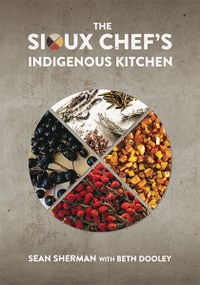
Note also that while there are many meat or fish dishes, they occupy no more prominence than non-meat or fish recipes. With an eye for plants and fruits that complement and lend a distinctive taste, these dishes incorporate all edible plant life. Using recipes from this book will confer particularly American flavors to your dishes and the amazing goodness that nature holds. But more than pleasing your taste buds, you’ll get closer to the purity of food from your local land and waterways, and a sense of what native food is, here.
How to Taste: the Curious Cook’s Handbook to Seasoning and Balance, from Umami to Acid and Beyond—with Recipes. / Becky Selengut, 2018. Sasquatch Books. 240 pages.
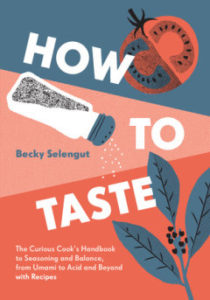 For most of us, flavor-enhancers we buy and store are the least used items of our pantries. With How to Taste, you could educate yourself on the basics of flavoring. Becky Selengut, an accomplished chef and teacher, shares the secrets of 9 facets of taste and flavor in How to Taste: umami, sweet, sour, salty, bitter, fat, heat, aroma and texture. Experiments using your senses and 22 recipes accompany the text and illustrate how perfection is reached for each one.
For most of us, flavor-enhancers we buy and store are the least used items of our pantries. With How to Taste, you could educate yourself on the basics of flavoring. Becky Selengut, an accomplished chef and teacher, shares the secrets of 9 facets of taste and flavor in How to Taste: umami, sweet, sour, salty, bitter, fat, heat, aroma and texture. Experiments using your senses and 22 recipes accompany the text and illustrate how perfection is reached for each one.
Dandelion & Quince : Exploring the Wide World of Unusual Vegetables, Fruits, and Herbs. / Michelle McKenzie, 2016. Roost Books. 311 pages, illustrations in color.
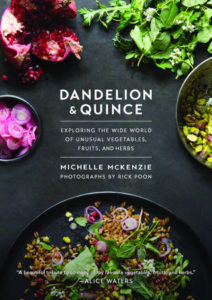 A beautifully-crafted book, Dandelion & Quince examines the flavors and textures of over 35 plants we hardly ever notice in the marketplace. Using everyday techniques, the recipes’ use familiar cooking methods—sauté-ing or roasting, baking, broiling, sauces, marinades, ferments, creamy-ness, sweeteners, etc., etc. The author’s emphasis on whole food and the freshest in-season ingredients certainly meets with my approval, and many recipes could be considered vegan, although a number of others feature eggs, dairy or meat.
A beautifully-crafted book, Dandelion & Quince examines the flavors and textures of over 35 plants we hardly ever notice in the marketplace. Using everyday techniques, the recipes’ use familiar cooking methods—sauté-ing or roasting, baking, broiling, sauces, marinades, ferments, creamy-ness, sweeteners, etc., etc. The author’s emphasis on whole food and the freshest in-season ingredients certainly meets with my approval, and many recipes could be considered vegan, although a number of others feature eggs, dairy or meat.
For each vegetable, herb or fruit McKenzie provides three or four recipes. If a fruit is usually purchased to make sweet desserts, an exception is Kumquat. It’s distinguished as tiny—smaller than Mandarin oranges—and citrus-like in character. Kumquat or “golden orange” is prepared in salad, cooked as a preserve, infused as tea, slow-cooked with beef, and sliced for poppy seed cake.
Especially in winter season and for holidays, trying out a new ingredient gives us a chance to experiment with seasonally-rich ingredients. Add joyous celebration to your dinners and get acquainted with Buddha’s hand, Celeriac, Daikon radish, Persimmon, Quince, Tomatillo. These fruits, vegetables and herbs, commonplace in other cultures, the Middle East, China, and Japan, are prepared as distinctly American plates. Have some this season!
Follow


